Experimental Evaluation of Fire Resistance Limits for Steel Constructions with Fire-Retardant Coatings at Various Fire Conditions
Abstract
:1. Introduction
- The modeling of fire spread in a warehouse building for various fire loads accepted in the Russian Federation on the basis of multi-year experimental research taking into account international experience;
- Modeling of load-bearing construction heating for standard temperature mode and for temperature modes from modeling process;
- The equivalent fire duration was determined for load-bearing constructions and the experimental evaluation of burning characteristics for fire-retardant paints were fulfilled for various heat flows.
2. Materials and Methods
2.1. Warehouse Description
2.2. Research Methods
- -
- heat flux 20 kW/m2, 30 kW/m2, 40 kW/m2, and 50 kW/m2;
- -
- εp = 0.95;
- -
- Ta is the temperature is measured inside the plate;
- -
- σ is the Stefan–Boltzmann constant.
3. Results and Discussion
3.1. FDS Modeling Results
3.2. ANSYS Modeling Results
3.3. Fire Test Results for Fire Paint
4. Conclusions
Author Contributions
Funding
Institutional Review Board Statement
Informed Consent Statement
Data Availability Statement
Conflicts of Interest
References
- McKeen, L. The Effect of Long Term Thermal Exposure on Plastics and Elastomers, 2nd ed.; William Andrew: Norwich, NY, USA, 2021. [Google Scholar]
- Chen, Y.J.; Lai, Y.S.; Lin, Y.H. BIM-based augmented reality inspection and maintenance of fire safety equipment. Autom. Constr. 2020, 110, 103041. [Google Scholar] [CrossRef]
- Perera, D.; Upasiri, I.R.; Poologanathan, K.; Gatheeshgar, P.; Sherlock, P.; Hewavitharana, T.; Suntharalingam, T. Energy performance of fire rated LSF walls under UK climate conditions. J. Build. Eng. 2021, 44, 103293. [Google Scholar] [CrossRef]
- Johnston, R.P.D.; Lim, J.B.P.; Sonebi, M.; Wrzesien, A.M.; Armstrong, C. The Structural Behaviour in Fire of a Cold-Formed Steel Portal Frame Having Semi-Rigid Joints. Available online: https://www.semanticscholar.org/paper/The-structural-behaviour-in-fire-of-a-cold-formed-Johnston-Lim/39855c2970a9929f79cf35afd48e0e5959808510 (accessed on 15 October 2021).
- Kruppa, I. Coolapse Temperature of Steel Structures. J. Struct. Div. 1979, 105, 1769–1788. [Google Scholar] [CrossRef]
- Dorn, I.E. Progress in Understanding High Temperature Creep; Grillet Memorial Lecture; ASTM: Philadelphia, PA, USA, 1962; p. 128. [Google Scholar]
- Tohr, I. Deformation and critical loads of steel beams under fire exposure conditions. Stockholm 1973, 35, 123. [Google Scholar]
- Yakovlev, A. Calculation of Fire Resistance of Building Structures; Stroiizdat: Moskow, Russia, 1988; p. 144. [Google Scholar]
- Molchadsky, I. Fire in Enclosure; Vniipo: Balashikha, Russia, 2005; p. 456. [Google Scholar]
- Roitman, V. Engineering Solutions for Fire Resistance Evaluation for Designed and Reconstructed Buildings; MGSU: Moskow, Russia, 2001; p. 382. [Google Scholar]
- Golovanov, V.; Kryuchkov, G. Steel Structures Fire Resistance Assessment under Standardized Fire Temperature Regimes. Fires and Incidents: Prevention. Accid. Response 2021, 3, 52–60. [Google Scholar]
- Guzman, N.H.C.; Kozine, I.; Lundteigen, M.A. An integrated safety and security analysis for cyber-physical harm scenarios. Saf. Sci. 2021, 144, 105458. [Google Scholar] [CrossRef]
- Wang, Q.; Zhang, C. Fire Safety Analysis of Building Partition Wall Engineering. Procedia Eng. 2018, 211, 747–754. [Google Scholar] [CrossRef]
- Nguyen, K.T.Q.; Navaratnam, S.; Mendis, P.; Zhang, K.; Barnett, J.; Wang, H. Fire safety of composites in prefabricated buildings: From fibre reinforced polymer to textile reinforced concrete. Compos. Part B Eng. 2020, 187, 107815. [Google Scholar] [CrossRef]
- Zhang, T.; Xi, J.; Qiu, S.; Zhang, B.; Luo, Z.; Xing, W.; Song, L.; Hu, Y. Facilely produced highly adhered, low thermal conductivity and non-combustible coatings for fire safety. J. Colloid Interface Sci. 2021, 604, 378–389. [Google Scholar] [CrossRef]
- Siddiqui, A.A.; Ewer, J.A.; Lawrence, P.J.; Galea, E.R.; Frost, I.R. Building Information Modelling for performance-based Fire Safety Engineering analysis—A strategy for data sharing. J. Build. Eng. 2021, 42, 102794. [Google Scholar] [CrossRef]
- Smith, T.D.; DeJoy, D.M.; Dyal, M.-A.; Pu, Y.; Dickinson, S. Multi-level safety climate associations with safety behaviors in the fire service. J. Saf. Res. 2019, 69, 53–60. [Google Scholar] [CrossRef] [PubMed]
- Sharma, A.; Singh, P.K.; Kumar, Y. An integrated fire detection system using IoT and image processing technique for smart cities. Sustain. Cities Soc. 2020, 61, 102332. [Google Scholar] [CrossRef]
- Babkin, O.E.; Zybina, O.A.; Tanklevsky, J.I.T.; Mnatsakanov, S.S. Diagnostics of the application quality and efficiency of coke-forming fire-protective coatings for metal structures. Ind. Coat. 2014, 7–8, 50–54. [Google Scholar]
- Zybina, O.A.; Babkin, O.E.; Tanklevsky, L.T.; Mnatsakanov, S.S. Formation of an intumescent layer during thermolysis of organophosphate-ammonium fire-retardant coatings. World Electroplat. 2014, 5, 56–58. [Google Scholar]
- Leong, W.I.; Lo, O.L.I.; Cheng, F.T.; Cheong, W.M.; Seak, L.C.U. Using recombinant adhesive proteins as durable and green flame-retardant coatings. Synth. Syst. Biotechnol. 2021, 6, 369–376. [Google Scholar] [CrossRef] [PubMed]
- Song, F.; Liu, T.; Fan, Q.; Li, D.; Ou, R.; Liu, Z.; Wang, Q. Sustainable, high-performance, flame-retardant waterborne wood coatings via phytic acid based green curing agent for melamine-urea-formaldehyde resin. Prog. Org. Coat. 2022, 162, 106597. [Google Scholar] [CrossRef]
- Qi, L.; Qiu, S.; Xi, J.; Yu, B.; Hu, Y.; Xing, W. Construction of super-hydrophobic, highly effective flame retardant coating for cotton fabric with superior washability and abrasion resistance. J. Colloid Interface Sci. 2021, 607, 2019–2028. [Google Scholar] [CrossRef]
- Rasoulipour, S.; Fleischmann, C.; Mercieca, L.; Adams, N. Flammability of engineered wood pyrolysis gases at anaerobic condition. Fire Saf. J. 2021, 125, 103424. [Google Scholar] [CrossRef]
- Oswald, D. Homeowner vulnerability in residential buildings with flammable cladding. Saf. Sci. 2021, 136, 105185. [Google Scholar] [CrossRef]
- Kalali, E.N.; Zhang, L.; Shabestari, M.E.; Croyal, J.; Wang, D.-Y. Flame-retardant wood polymer composites (WPCs) as potential fire safe bio-based materials for building products: Preparation, flammability and mechanical properties. Fire Saf. J. 2019, 107, 210–216. [Google Scholar] [CrossRef]
- Li, P.; Liu, C.; Wang, B.; Tao, Y.; Xu, Y.-J.; Liu, Y.; Zhu, P. Eco-friendly coating based on an intumescent flame-retardant system for viscose fabrics with multi-function properties: Flame retardancy, smoke suppression, and antibacterial properties. Prog. Org. Coat. 2021, 159, 106400. [Google Scholar] [CrossRef]
- Morandini, F.; Santoni, P.; Tramoni, J.; Mell, W. Experimental investigation of flammability and numerical study of combustion of shrub of rockrose under severe drought conditions. Fire Saf. J. 2019, 108, 102836. [Google Scholar] [CrossRef]
- Dos Santos, D.M.; Goiato, M.C.; Moreno, A.; Pesqueira, A.; Dekon, S.F.D.C.; Guiotti, A.M. Effect of addition of pigments and opacifier on the hardness, absorption, solubility and surface degradation of facial silicone after artificial ageing. Polym. Degrad. Stab. 2012, 97, 1249–1253. [Google Scholar] [CrossRef]
- Tong, C.; Zhang, S.; Zhong, T.; Fang, Z.; Liu, H. Highly fibrillated and intrinsically flame-retardant nanofibrillated cellulose for transparent mineral filler-free fire-protective coatings. Chem. Eng. J. 2021, 419, 129440. [Google Scholar] [CrossRef]
- De Masi, R.F.; Ruggiero, S.; Vanoli, G.P. Acrylic white paint of industrial sector for cool roofing application: Experimental investigation of summer behavior and aging problem under Mediterranean climate. Sol. Energy 2018, 169, 468–487. [Google Scholar] [CrossRef]
- Gatheeshgar, P.; Poologanathan, K.; Thamboo, J.; Roy, K.; Rossi, B.; Molkens, T.; Perera, D.; Navaratnam, S. On the fire behaviour of modular floors designed with optimised cold-formed steel joist. Structures 2021, 30, 1071–1085. [Google Scholar] [CrossRef]
- Roy, K.; Lim, J.B.; Lau, H.H.; Yong, P.M.; Clifton, G.C.; Johnston, R.P.; Wrzesien, A.; Mei, C.C. Collapse behaviour of a fire engineering designed single-storey cold-formed steel building in severe fires. Thin-Walled Struct. 2019, 142, 340–357. [Google Scholar] [CrossRef]
- Johnston, R.P.D.; Lim, J.B.P.; Lau, H.H.; Xu, Y.; Sonebi, M.; Armstrong, C.G.; Mei, C.C. Finite-element investigation of cold-formed steel portal frames in fire. Proc. Inst. Civ. Eng.-Struct. Build. 2015, 169, 3–19. [Google Scholar] [CrossRef] [Green Version]
- Johnston, R.; Lim, J.; Lau, H.H.; Xu, Y.; Sonebi, M.; Armstrong, C.; Switzer, C.; Mei, C. Cold-formed steel portal frames in fire: Full-scale testing and finite element analysis. Struct. Eng. 2014, 92, 44–50. [Google Scholar]
- Shi, J.; Li, Y.; Chen, H. Application of Computer Integration Technology for Fire Safety Analysis. Tsinghua Sci. Technol. 2008, 13, 387–392. [Google Scholar] [CrossRef]
- Kim, S.H.; Huh, K.Y. Assessment of The Finite-Volume Method and The Discrete Ordinate Method for Radiative Heat Transfer in a Three-Dimensional Rectangular Enclosure. Numer. Heat Transf. Part B Fundam. 1999, 35, 85–112. [Google Scholar]
- Eremina, T.Y.; Fadeev, V.E.; Kadochnikova, E.N. Normative regulation of issues of ensuring fire safety of airport buildings. Prospects for the construction and development of airports in the Arctic region. In Proceedings of the Materials of the VI International Scientific and Practical Conference “Security Service in Russia: Experience, Problems, Prospects”, Saint Petersburg, Russia, 10 November 2014; pp. 80–83. [Google Scholar]
- Chi, L.; Su, H.; Zio, E.; Zhang, J.; Li, X.; Zhang, L.; Fan, L.; Zhou, J.; Bai, H. Integrated Deterministic and Probabilistic Safety Analysis of Integrated Energy Systems with bi-directional conversion. Energy 2020, 212, 118685. [Google Scholar] [CrossRef]
- Ushanov, V.V.; Fadeev, V.E.; Kharitonov, V.S.; Shchelkunov, V.I.; Pavlovsky, A.V.; Kosachev, A.A. Fire resistance and fire hazard of sandwich panels and proposals for amendments to regulatory legal acts on fire safety in terms of their application in buildings and structures for various functional purposes. Fire Saf. 2016, 4, 119–122. [Google Scholar]
- Kumar, A.; Roy, K.; Uzzaman, A.; Lim, J.B.P. Finite element analysis of unfastened cold-formed steel channel sections with web holes under end-two-flange loading at elevated temperatures. Adv. Steel Constr. 2021, 17, 231–242. [Google Scholar]
- Cui, M.; Li, J.; Chen, X.; Hong, W.; Chen, Y.; Xiang, J.; Yan, J.; Fan, H. A halogen-free, flame retardant, waterborne polyurethane coating based on the synergistic effect of phosphorus and silicon. Prog. Org. Coat. 2021, 158, 106359. [Google Scholar] [CrossRef]
- Liu, C.; Zhang, T.; Luo, Y.; Wang, Y.; Li, J.; Ye, T.; Guo, R.; Song, P.; Zhou, J.; Wang, H. Multifunctional polyurethane sponge coatings with excellent flame retardant, antibacterial, compressible, and recyclable properties. Compos. Part B Eng. 2021, 215, 108785. [Google Scholar] [CrossRef]
- Rahman, M.Z.; Kundu, C.K.; Nabipour, H.; Wang, X.; Song, L.; Hu, Y. Flame retardant and hydrophilic coatings on undyed and dyed polyamide 6.6 textiles: Clarifying the processing and performance. Prog. Org. Coat. 2021, 163, 106600. [Google Scholar] [CrossRef]
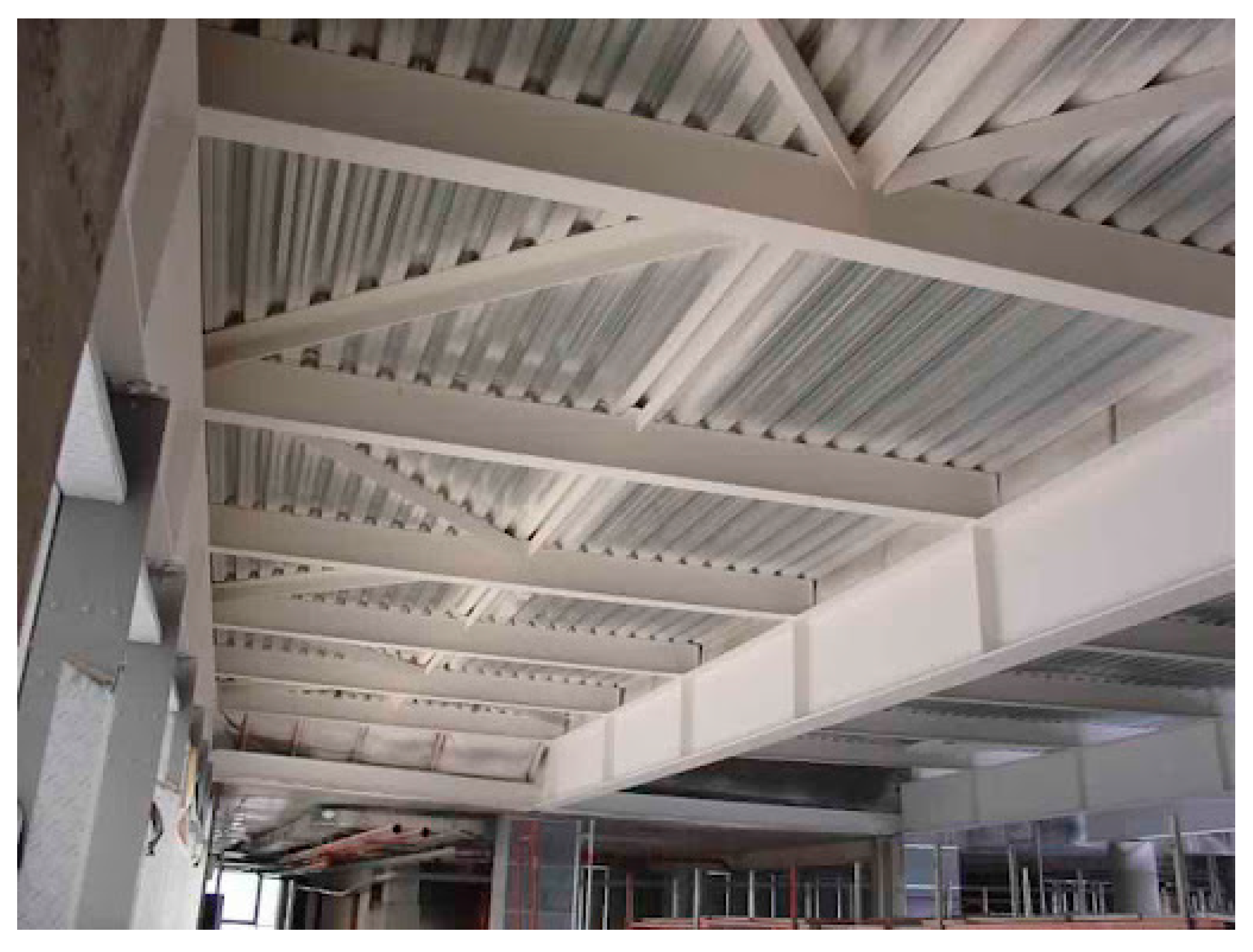
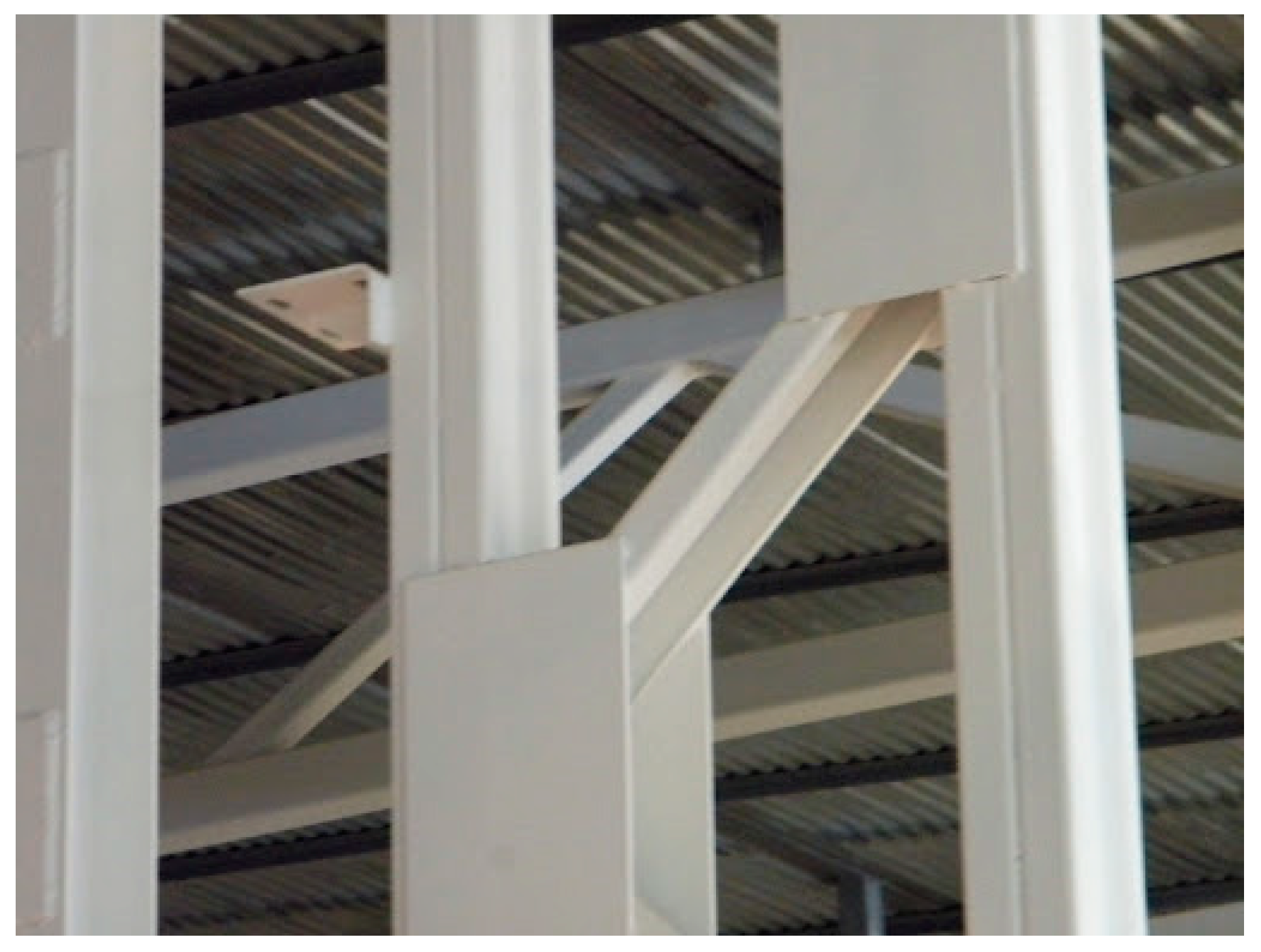

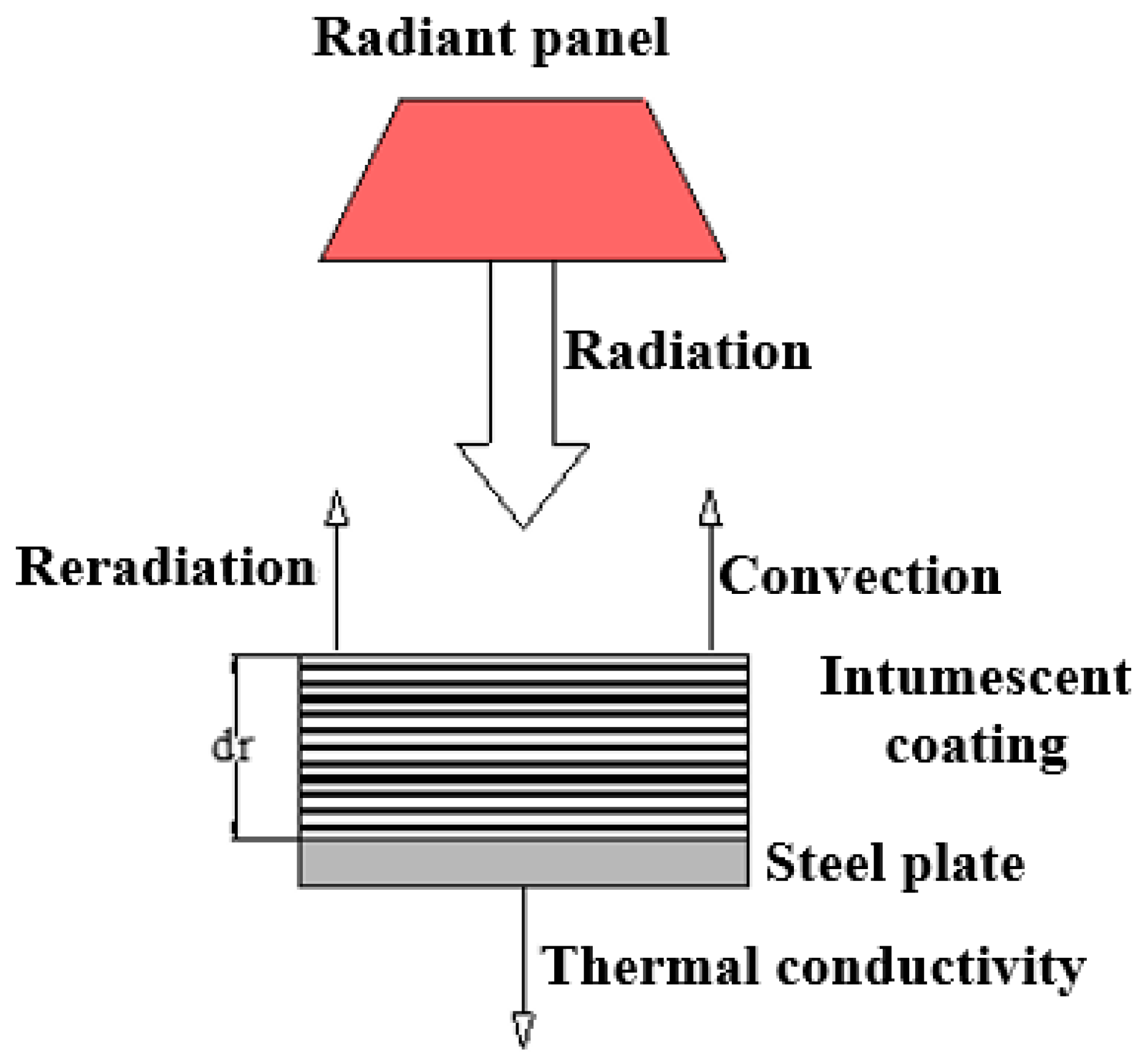
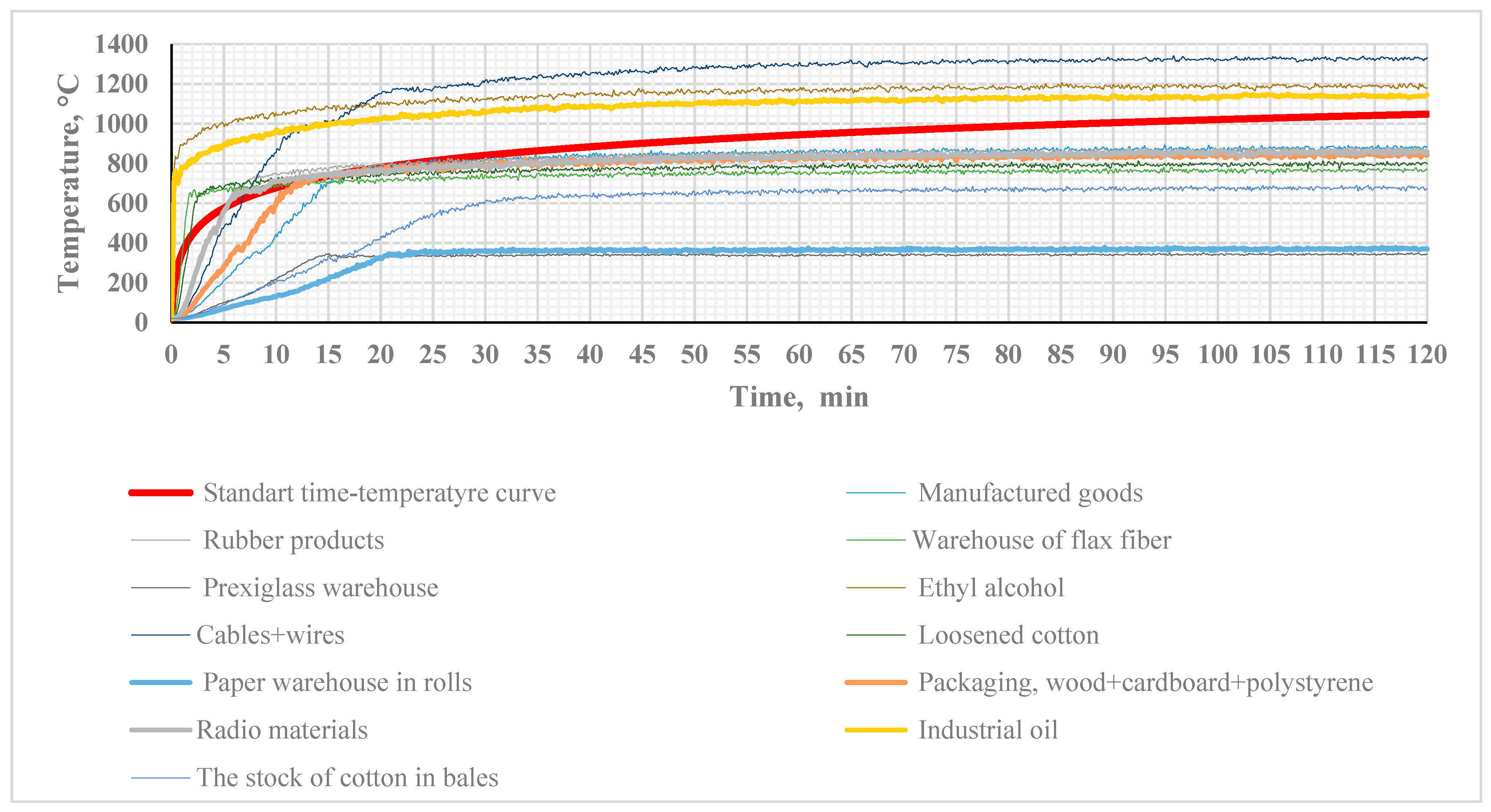
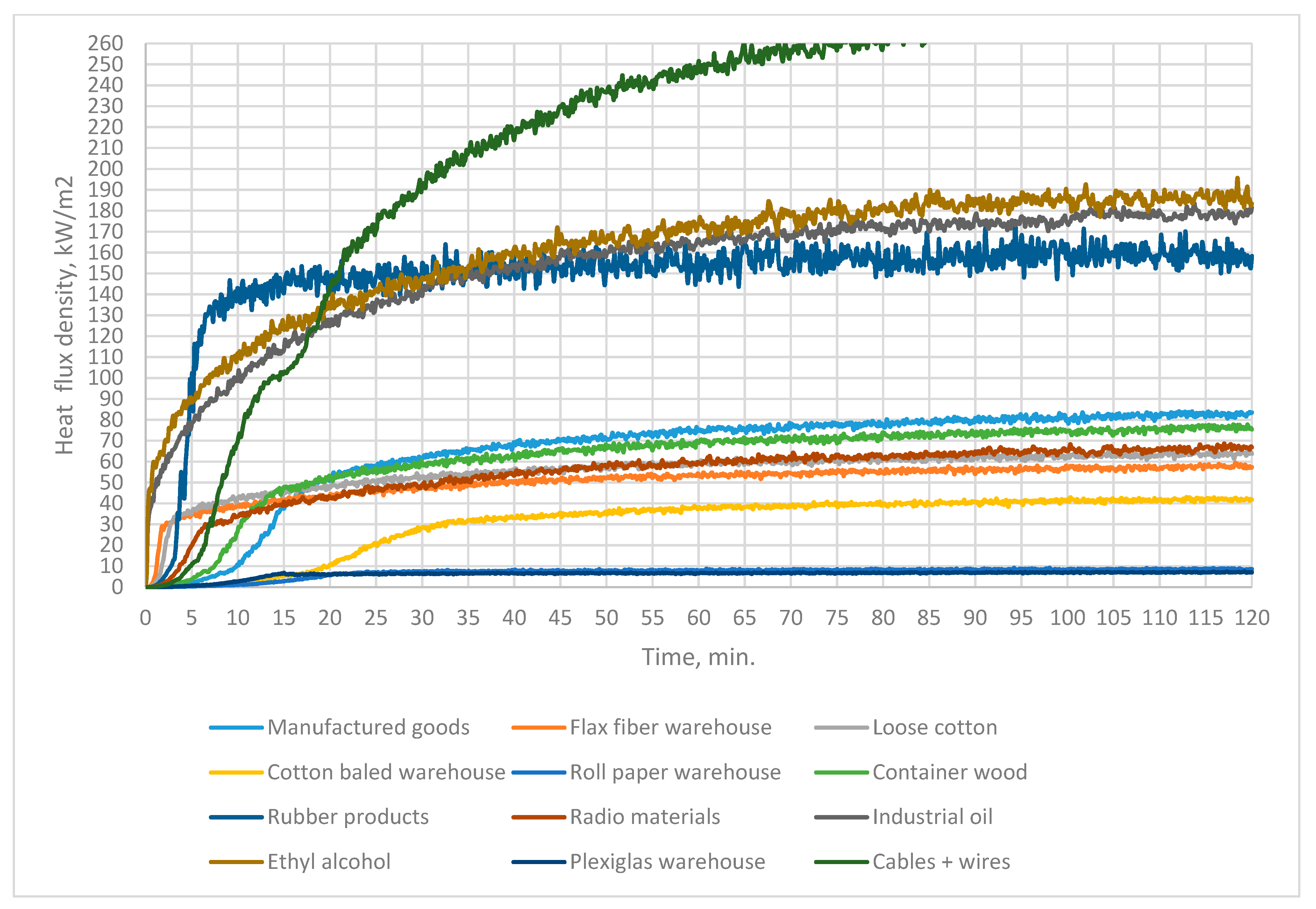
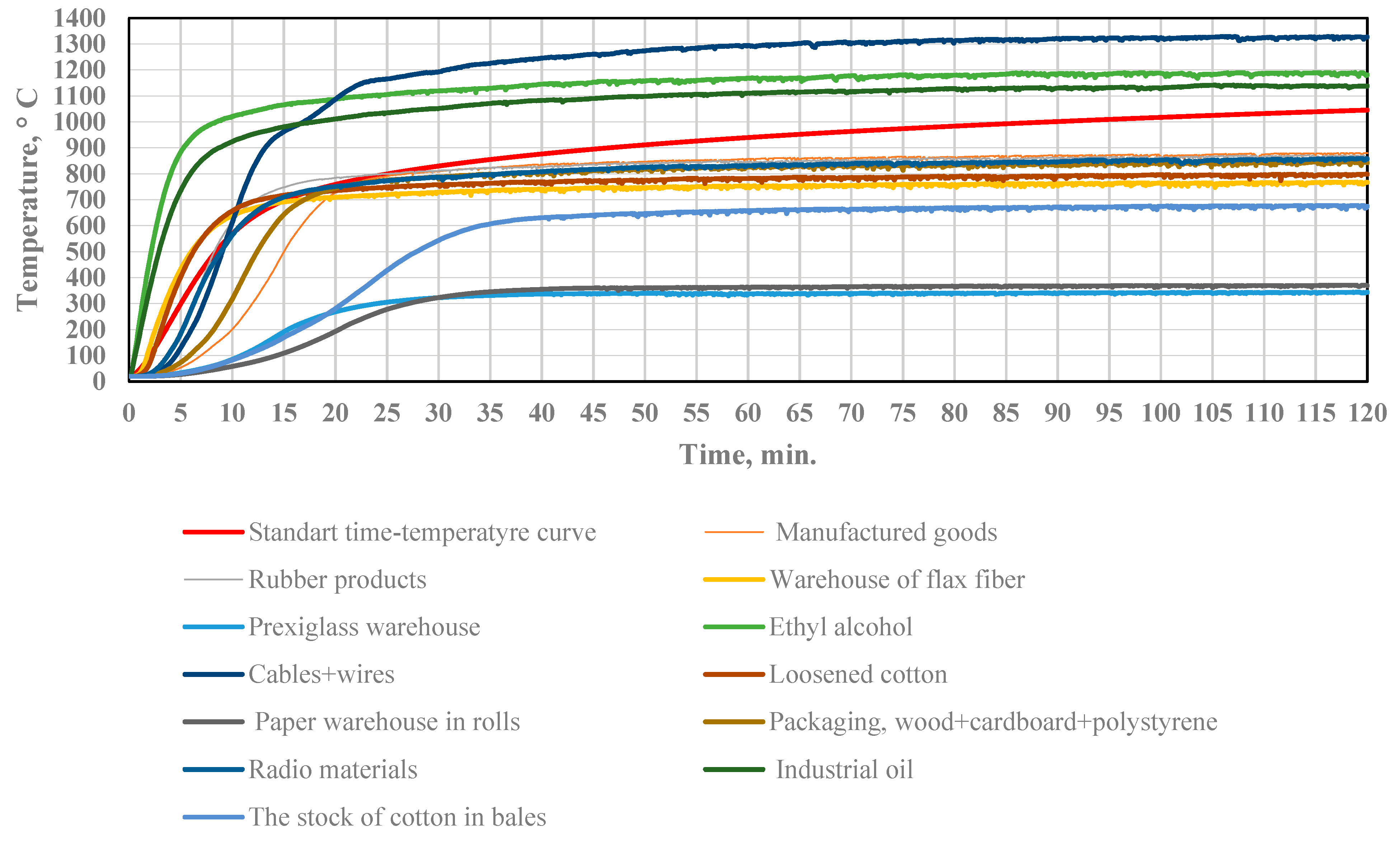

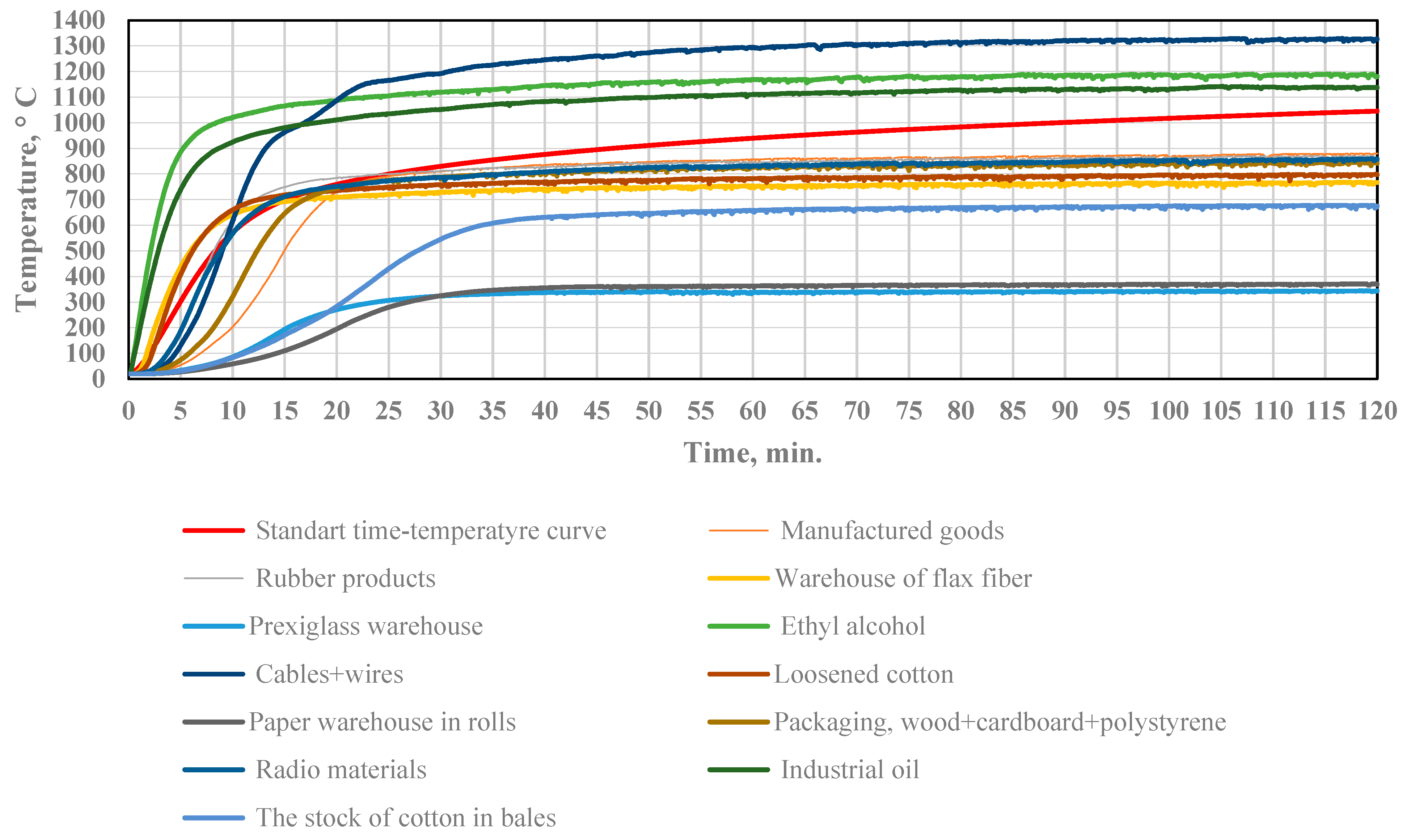
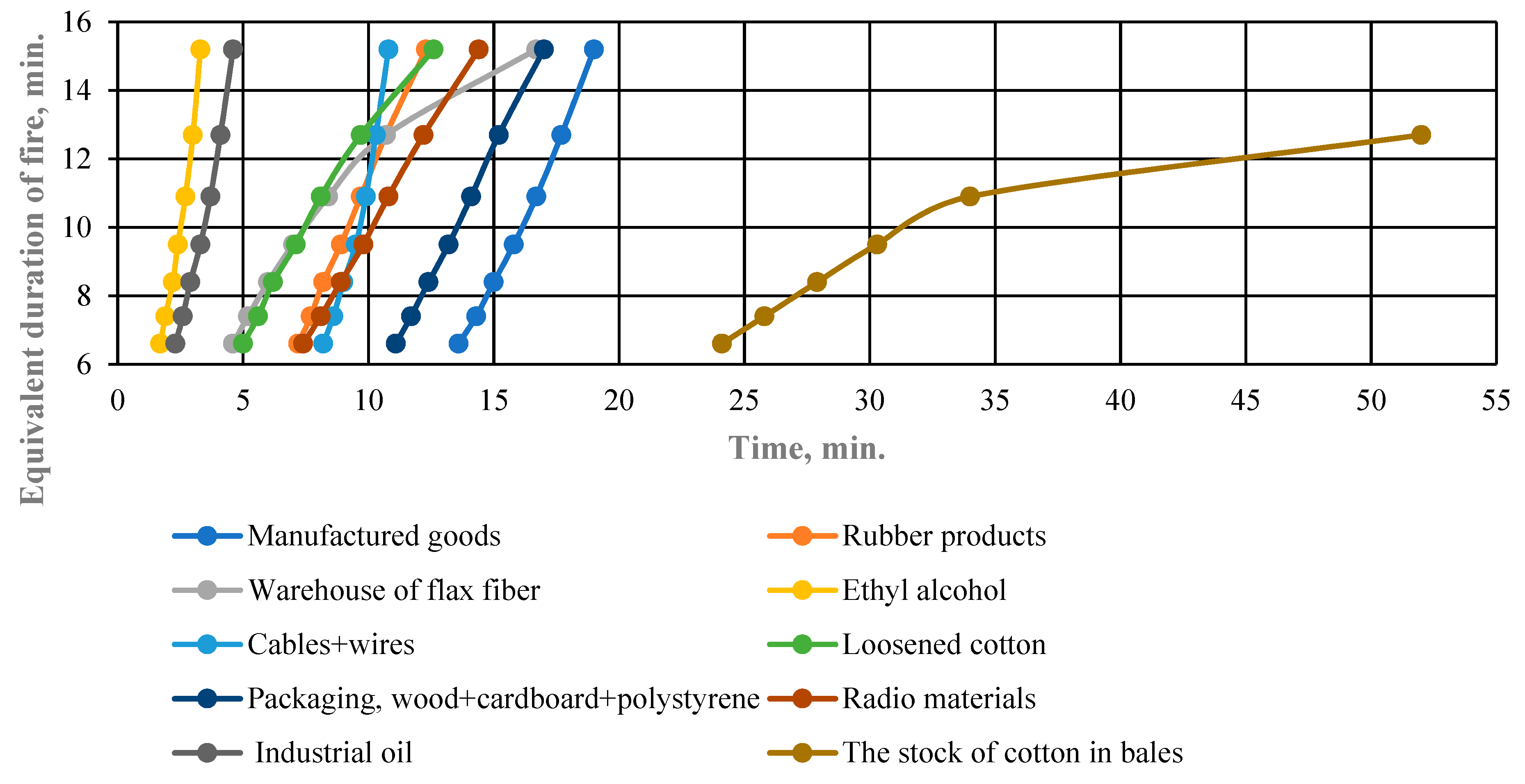

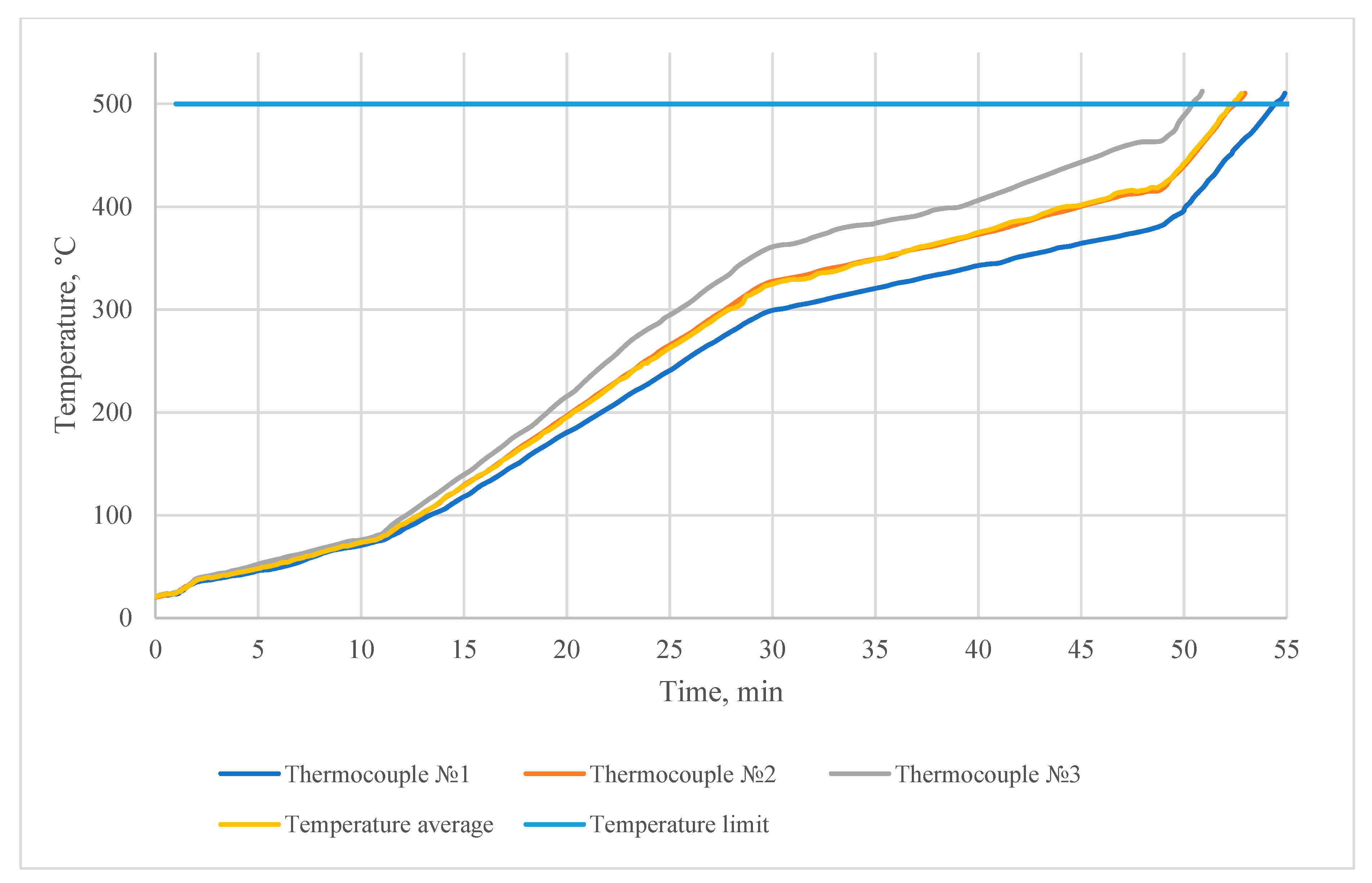

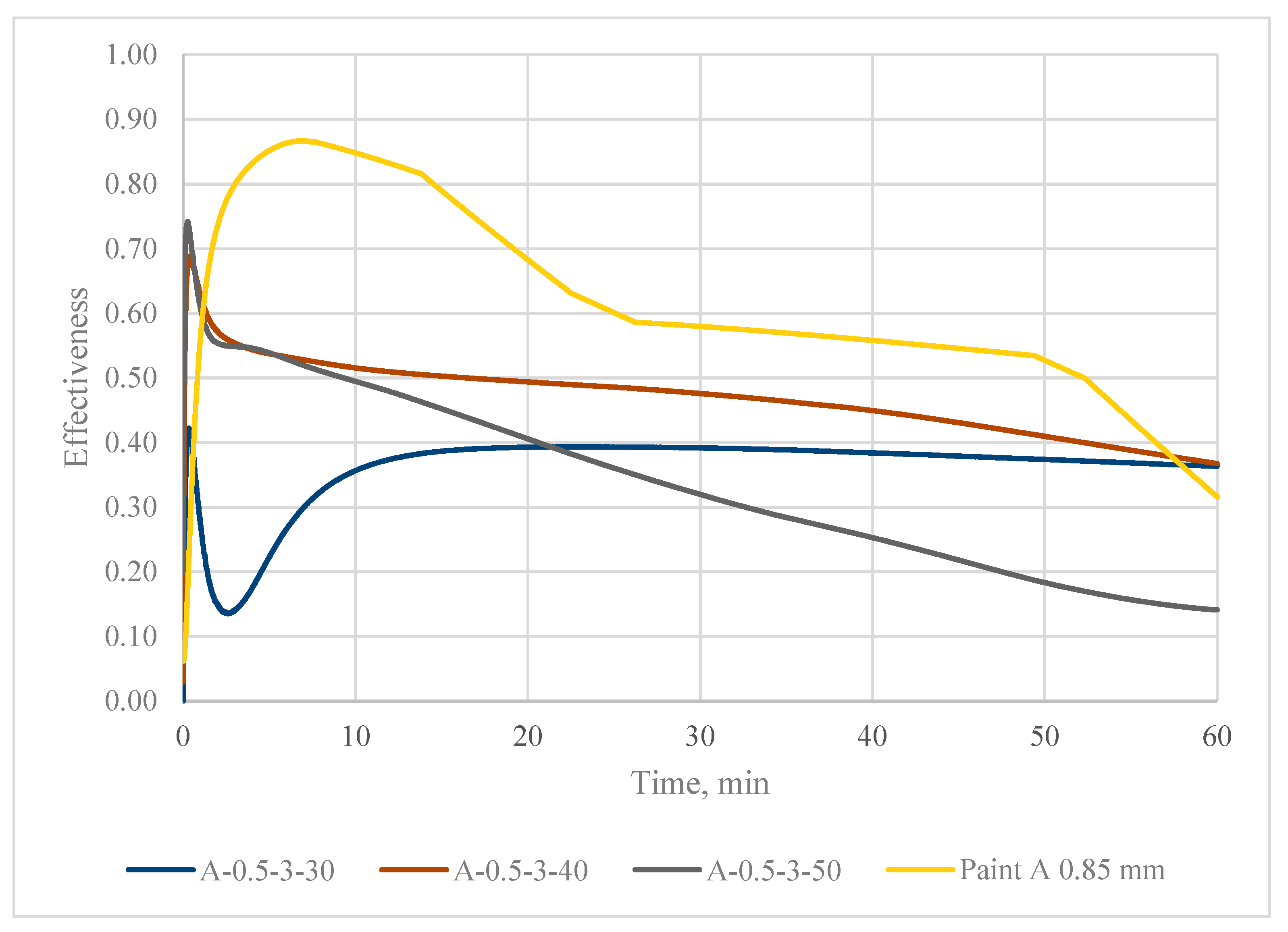
| Description | Fire Resistance Rating—Mass Factor | Dry Layer Thickness, mm—Flow Rate, kg/m2 | Drying Time, h | Indoor/Outdoor Application | Type (Base) |
|---|---|---|---|---|---|
| Unikum flame-retardant paint for steel structures | R45-2.4 R60-3.4 | 0.8–0.6 1.2–0.9 | 12 | indoors | water |
| BICOAT FIRE 101 brand flame-retardant paint for steel structures | R45-3.4 R60-3.4 | 0.85–1.51 1.25–2.23 | 4 | indoors | organic |
| DEKOTERM R flame-retardant paint for steel structures | R45-3.4 R90-5.8 | 0.87–1.48 1.75–2.95 | 6 | indoors | organic |
| OZK-45 brand flame-retardant paint for steel structures | R45-3.4 R60-3.4 R90-5.8 | 1.07–1.93 1.72–3.10 1.77–3.19 | 8 | indoors | water |
| EKOTERM-S brand flame-retardant paint for treatment of steel structures | R90-5.8 | 1.71–2.52 | 6 | indoors | water |
| Element | Cross-Section | Dimensions, mm | Cross-Section Area, mm2 | Perimeter of Heated Surface, mm | Effective Metal Thickness, mm |
|---|---|---|---|---|---|
| 1 | rectangular | a = 160, b = 160, h = 5 | 3100 | 640 | 4.84 |
| 2 | rectangular | a = 140, b = 140, h = 5 | 2700 | 560 | 4.82 |
| 3 | rectangular | a = 100, b = 100, h = 5 | 1900 | 400 | 4.75 |
| Parameter | Formula | Note |
|---|---|---|
| Coefficient α, W/(m2 deg), from the heating medium with temperature tB, τ to the surface with temperature t0 | αc—the convective factor; αr—the radiant factor; sr—the reduced emissivity factor of the heating medium and structure surface. | |
| Reduced emissivity factor | s—the emissivity factor of the furnace fire chamber. S = 0.85; s0—the emissivity factor of the heated surface of the structure; s0 = 0.74 for unprotected steel structures. |
| Parameter | Formula | Note |
|---|---|---|
| Maximum design time interval Δτmax | , F—cross-sectional area of the rod, m2; P—heated perimeter of the rod cross-section, m. | |
| Algorithm for calculating the temperature of unprotected metal structures | tcm,Δτ—rod temperature in the calculated time interval Δτ, 0K; tcm—rod temperature at a given time τ, 0K; tB,τ—temperature of the heating medium at a given time τ, 0K; α—heat transfer coefficient from the heating medium to the structure surface, W/(m2 deg); Ccm—initial metal heat capacity coefficient, J/(kg deg); Dcm—coefficient of change of heat capacity of metal at heating, J/(kg deg2); γ—metal specific weight, J/(kg/m3); δef—effective thickness of metal, m. |
| Structure Type | Temperature, °C | Structure Heating Time, min. | ||||||||||||
|---|---|---|---|---|---|---|---|---|---|---|---|---|---|---|
| 1 * | 2 * | 3 * | 4 * | 5 * | 6 * | 7 * | 8 * | 9 * | 10 * | 11 * | 12 * | 13 * | ||
| 160 × 160 × 5 | 400 | 6.6 | 13.6 | 7.2 | 4.6 | - | 1.7 | 8.2 | 5.0 | - | 11.1 | 7.4 | 2.3 | 24.1 |
| 140 × 140 × 5 | 6.6 | 13.6 | 7.2 | 4.6 | - | 1.7 | 8.2 | 5.0 | - | 11.1 | 7.4 | 2.3 | 24.1 | |
| 100 × 100 × 5 | 6.5 | 13.5 | 7.1 | 4.5 | - | 1.7 | 8.1 | 4.9 | - | 11.0 | 7.3 | 2.2 | 24.0 | |
| 160 × 160 × 5 | 450 | 7.4 | 14.3 | 7.7 | 5.2 | - | 1.9 | 8.6 | 5.6 | - | 11.7 | 8.1 | 2.6 | 25.8 |
| 140 × 140 × 5 | 7.4 | 14.3 | 7.7 | 5.2 | - | 1.9 | 8.6 | 5.6 | - | 11.7 | 8.1 | 2.6 | 25.8 | |
| 100 × 100 × 5 | 7.4 | 14.3 | 7.7 | 5.2 | - | 1.9 | 8.6 | 5.5 | - | 11.7 | 8.0 | 2.5 | 25.7 | |
| 160 × 160 × 5 | 500 | 8.4 | 15.0 | 8.2 | 6.0 | - | 2.2 | 9.0 | 6.2 | - | 12.4 | 8.9 | 2.9 | 27.9 |
| 140 × 140 × 5 | 8.4 | 15.0 | 8.2 | 6.0 | - | 2.1 | 9.0 | 6.2 | - | 12.4 | 8.9 | 2.9 | 27.8 | |
| 100 × 100 × 5 | 8.3 | 15.0 | 8.2 | 6.0 | - | 2.1 | 9.0 | 6.2 | - | 12.4 | 8.8 | 2.9 | 27.7 | |
| 160 × 160 × 5 | 550 | 9.5 | 15.8 | 8.9 | 7.0 | - | 2.4 | 9.5 | 7.1 | - | 13.2 | 9.8 | 3.3 | 30.3 |
| 140 × 140 × 5 | 9.5 | 15.8 | 8.9 | 7.0 | - | 2.4 | 9.5 | 7.1 | - | 13.2 | 9.8 | 3.2 | 30.3 | |
| 100 × 100 × 5 | 9.5 | 15.7 | 8.9 | 6.9 | - | 2.4 | 9.4 | 7.0 | - | 13.1 | 9.7 | 3.2 | 30.2 | |
| 160 × 160 × 5 | 600 | 10.9 | 16.7 | 9.7 | 8.4 | - | 2.7 | 9.9 | 8.1 | - | 14.1 | 10.8 | 3.7 | 34.0 |
| 140 × 140 × 5 | 10.9 | 16.7 | 9.7 | 8.3 | - | 2.7 | 9.9 | 8.1 | - | 14.1 | 10.8 | 3.6 | 34.0 | |
| 100 × 100 × 5 | 10.8 | 16.7 | 9.7 | 8.2 | - | 2.6 | 9.9 | 8.1 | - | 14.0 | 10.7 | 3.6 | 33.9 | |
| 160 × 160 × 5 | 650 | 12.7 | 17.7 | 10.7 | 10.7 | - | 3.0 | 10.3 | 9.7 | - | 15.2 | 12.2 | 4.1 | 52.0 |
| 140 × 140 × 5 | 12.7 | 17.7 | 10.7 | 10.6 | - | 3.0 | 10.3 | 9.7 | - | 15.2 | 12.2 | 4.1 | 52.0 | |
| 100 × 100 × 5 | 12.6 | 17.7 | 10.7 | 10.5 | - | 2.9 | 10.3 | 9.6 | - | 15.1 | 12.1 | 4.0 | 52.0 | |
| 160 × 160 × 5 | 700 | 15.2 | 19.0 | 12.3 | 16.7 | - | 3.3 | 10.8 | 12.6 | - | 17.0 | 14.4 | 4.6 | - |
| 140 × 140 × 5 | 15.2 | 19.0 | 12.2 | 16.7 | - | 3.3 | 10.8 | 12.6 | - | 17.0 | 14.3 | 4.6 | - | |
| 100 × 100 × 5 | 15.1 | 19.0 | 12.2 | 16.7 | - | 3.2 | 10.8 | 12.5 | - | 16.9 | 14.3 | 4.5 | - | |
Publisher’s Note: MDPI stays neutral with regard to jurisdictional claims in published maps and institutional affiliations. |
© 2022 by the authors. Licensee MDPI, Basel, Switzerland. This article is an open access article distributed under the terms and conditions of the Creative Commons Attribution (CC BY) license (https://creativecommons.org/licenses/by/4.0/).
Share and Cite
Eremina, T.; Korolchenko, D.; Minaylov, D. Experimental Evaluation of Fire Resistance Limits for Steel Constructions with Fire-Retardant Coatings at Various Fire Conditions. Sustainability 2022, 14, 1962. https://doi.org/10.3390/su14041962
Eremina T, Korolchenko D, Minaylov D. Experimental Evaluation of Fire Resistance Limits for Steel Constructions with Fire-Retardant Coatings at Various Fire Conditions. Sustainability. 2022; 14(4):1962. https://doi.org/10.3390/su14041962
Chicago/Turabian StyleEremina, Tatiana, Dmitry Korolchenko, and Denis Minaylov. 2022. "Experimental Evaluation of Fire Resistance Limits for Steel Constructions with Fire-Retardant Coatings at Various Fire Conditions" Sustainability 14, no. 4: 1962. https://doi.org/10.3390/su14041962
APA StyleEremina, T., Korolchenko, D., & Minaylov, D. (2022). Experimental Evaluation of Fire Resistance Limits for Steel Constructions with Fire-Retardant Coatings at Various Fire Conditions. Sustainability, 14(4), 1962. https://doi.org/10.3390/su14041962







